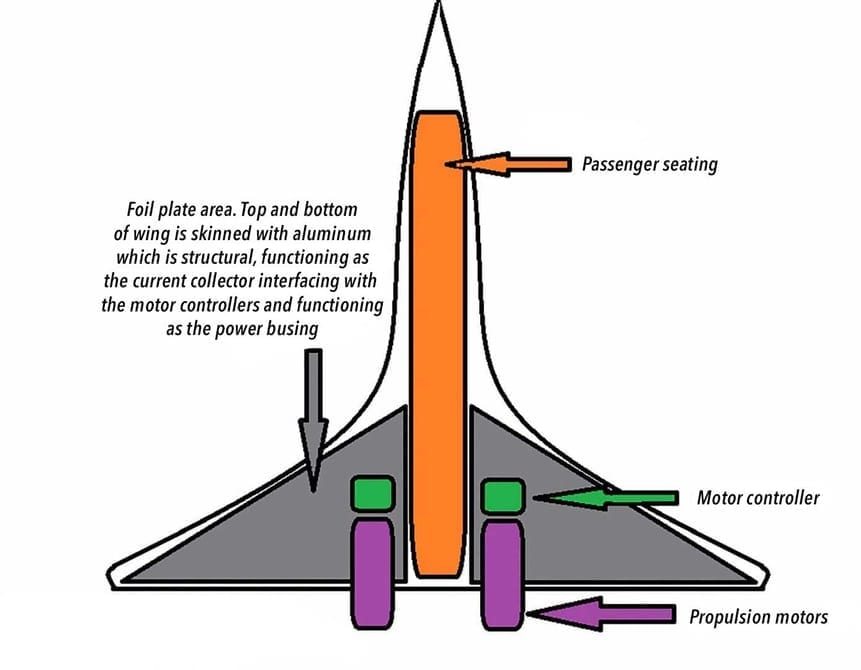
Credits: NASA Langley/David C. Bowman
Imagine a battery-powered plane that has 10 engines and can take off like a helicopter and fly efficiently like an aircraft.
That is a concept being developed by NASA researchers called Greased Lightning or GL-10.
The team, at NASA’s Langley Research Center in Hampton, Virginia, is looking at the idea initially as a potential unmanned aerial vehicle (UAV). “We have a couple of options that this concept could be good for,” said Bill Fredericks, aerospace engineer. “It could be used for small package delivery or vertical take off and landing, long endurance surveillance for agriculture, mapping and other applications. A scaled up version — much larger than what we are testing now — would make also a great one to four person size personal air vehicle.””
The GL-10 is currently in the design and testing phase. The initial thought was to develop a 20-foot wingspan (6.1 meters) aircraft powered by hybrid diesel/electric engines, but the team started with smaller versions for testing, built by rapid prototyping.
“We built 12 prototypes, starting with simple five-pound (2.3 kilograms) foam models and then 25-pound (11.3 kilograms), highly modified fiberglass hobby airplane kits all leading up to the 55-pound (24.9 kilograms), high quality, carbon fiber GL-10 built in our model shop by expert technicians, ” said aerospace engineer David North.
“Each prototype helped us answer technical questions while keeping costs down. We did lose some of the early prototypes to ‘hard landings’ as we learned how to configure the flight control system. But we discovered something from each loss and were able to keep moving forward.”
During a recent spring day the engineers took the GL-10 to test its wings at a military base about two hours away from NASA Langley. The remotely piloted plane has a 10-foot wingspan (3.05 meters), eight electric motors on the wings, two electric motors on the tail and weighs a maximum of 62 pounds (28.1 kilograms) at take off.
It had already passed hover tests — flying like a helicopter — with flying colors. But now was the big hurdle — the transition from vertical to forward “wing-borne” flight. As engineers who have designed full-scale vertical take off and landing tiltrotors such as the V-22 Osprey will tell you — that is no easy task because of the challenging flight aerodynamics.
“During the flight tests we successfully transitioned from hover to wing-borne flight like a conventional airplane then back to hover again. So far we have done this on five flights,” said Fredericks. “We were ecstatic. Now we’re working on our second goal — to demonstrate that this concept is four times more aerodynamically efficient in cruise than a helicopter.”
Read more: Ten-Engine Electric Plane Completes Successful Flight Test
The Latest on: Electric Aircraft
[google_news title=”” keyword=”Electric Aircraft” num_posts=”10″ blurb_length=”0″ show_thumb=”left”]
via Google News
The Latest on: Electric Aircraft
- Wright Builds Megawatt-Scale Electric Engine Cellon April 26, 2024 at 5:17 pm
U.S. startup Wright Electric has begun building a test cell to characterize the performance of its megawatt-scale electric propulsion systems for large commercial aircraft. Located in Albany, New York ...
- The Sexiest Electric Aircraft Around Turns Bland as It Clears Design Reviewon April 26, 2024 at 4:06 am
American aviation startup Eviation presents an evolved version of the Alice electric aircraft as it cleared the conceptual design review ...
- VoltAero begins certification tests of Cassio 330 hybrid-electric powertrainon April 25, 2024 at 7:50 pm
French aircraft developer VoltAero has begun certification testing of the parallel hybrid-electric powertrain that will equip its five-seat Cassio 330. Installed on a ground-test bench, the powertrain ...
- Joby Partners with Abu Dhabi to Establish Electric Air Taxi Ecosystemon April 25, 2024 at 9:36 am
Joby Aviation, Inc. (NYSE:JOBY) is a California-based transportation company developing an all-electric, vertical take-off and landing air taxi which it intends to operate as part of a fast, quiet, ...
- ZeroAvia Opens Electric Component Factoryon April 25, 2024 at 2:30 am
ZeroAvia Opens Electric Component Factory is published in Advanced Air Mobility Report, an Aviation Week Intelligence Network (AWIN) Market Briefing and is included with your AWIN Premium membership.
- ZeroAvia offers electric and hydrogen tech to other aviation innovatorson April 25, 2024 at 2:24 am
ZeroAvia has announced it will be offering some of its key components designed for its hydrogen-electric engines to other clean aviation innovators.
- Electric airplane towing concept could mean longer zero-emission flightson April 24, 2024 at 4:01 pm
Magpie Aviation announced a novel new approach to electric airplanes on Monday. Today’s battery technology (including CATL’s new, more efficient one) severely limits the practicality of zero-emission ...
- Sarasota test pilot eyes next electric flight altitude record in Helios Horizonon April 24, 2024 at 1:59 am
Sarasota-based engineer and test pilot Miguel Iturmendi flew his electric aircraft, Helios Horizon, to an altitude of 22,000 feet – the highest ever for a multi-seat electric aircraft – over ...
- Harbour Air plans to buy 50 electric motors from Everett company magniXon April 22, 2024 at 12:10 pm
One of the largest seaplane airlines in the world plans to retrofit its fleet with the Everett-built electric propulsion system.
- Electra.aero Nabs $1.9M Army Contract for Electric Aircraft Testingon April 18, 2024 at 12:54 pm
Electra will perform wind tunnel testing of its flagship, nine-passenger, hybrid-electric short takeoff and landing (eSTOL) aircraft.
via Bing News











